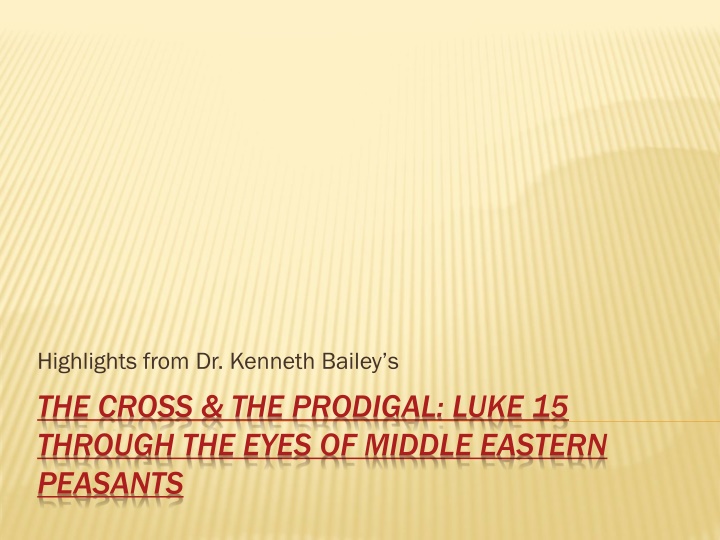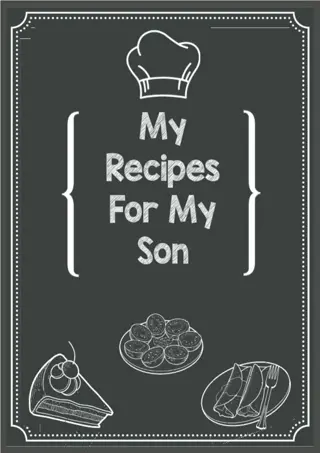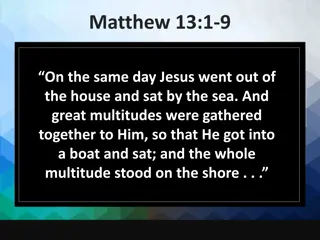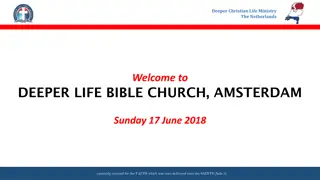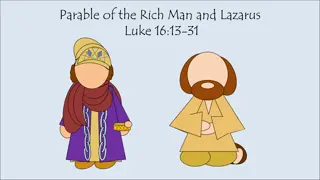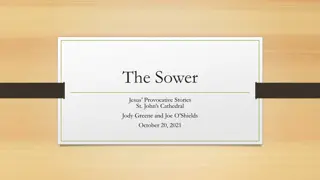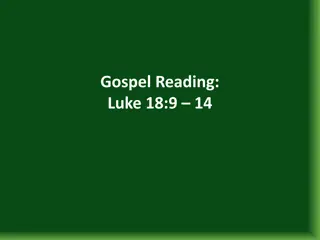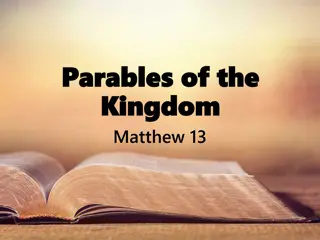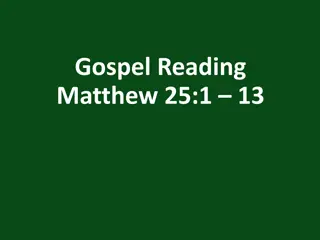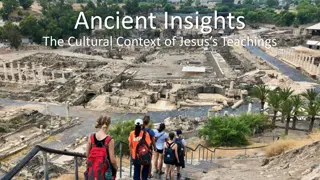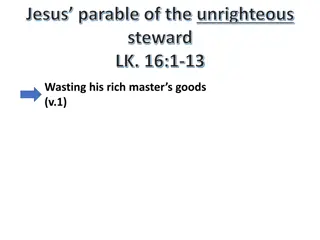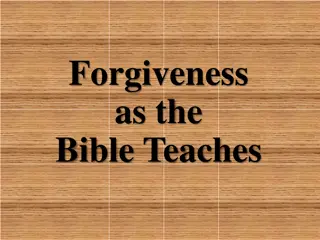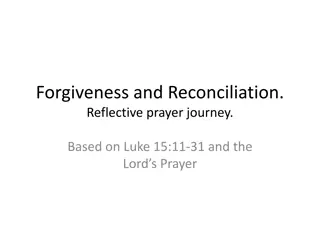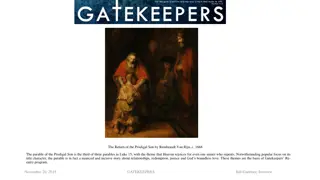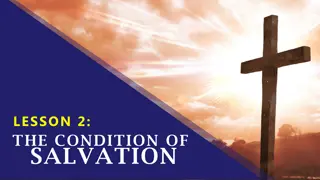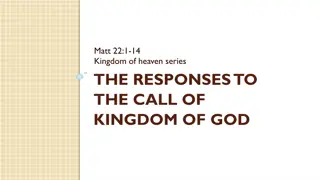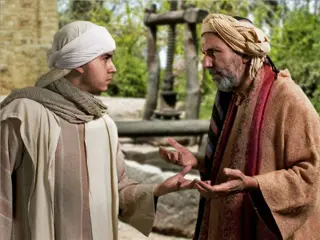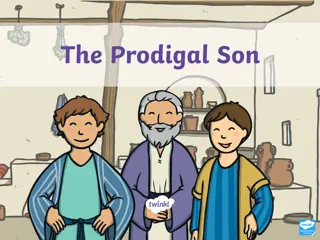Insights on Parable of Prodigal Son
Highlights from Dr. Kenneth Bailey's analysis of Luke 15 through Middle Eastern perspectives, shedding light on the Compassionate Father, the Race of Shame, the Kezazah custom, and the intersection of Islam with the parable's themes. Gain profound insights into the cultural nuances and theological depth of this timeless narrative.
Download Presentation

Please find below an Image/Link to download the presentation.
The content on the website is provided AS IS for your information and personal use only. It may not be sold, licensed, or shared on other websites without obtaining consent from the author.If you encounter any issues during the download, it is possible that the publisher has removed the file from their server.
You are allowed to download the files provided on this website for personal or commercial use, subject to the condition that they are used lawfully. All files are the property of their respective owners.
The content on the website is provided AS IS for your information and personal use only. It may not be sold, licensed, or shared on other websites without obtaining consent from the author.
E N D
Presentation Transcript
Highlights from Dr. Kenneth Baileys THE CROSS & THE PRODIGAL: LUKE 15 THROUGH THE EYES OF MIDDLE EASTERN PEASANTS
MIDDLE EASTERN INSIGHTS Perhaps a better name for the parable would be The Compassionate Father and the Two Lost Sons (Bailey, 40). V. 12 Such a request in village society means only one thing: The younger son is impatient for his father s death (Bailey, 40).
THE RACE OF SHAME The word run in Greek (dram n) is the technical term used for the foot-races in the stadium. Paul uses this word a number of times in this sense (1 Cor. 9:24, 26; Gal. 2:2; 5:7; 2 Thess. 3:1; Heb. 12:1). Luke is a well-educated man who chooses his words carefully. Thus we can translate the phrase, His father saw him and had compassion and raced In the Middle East a man of his age and position always walks in a slow, dignified fashion No villager over the age of twenty-five ever runs To do so, he must take the front edge of his robes in his hand like a teenager. When he does this, his legs show in what is considered a humiliating posture. All of this is painfully shameful for him (Bailey, 67).
RACE OF SHAME The loiterers in the street will be distracted from tormenting the prodigal and will instead run after the father, amazed at seeing this respected village elder shaming himself publicly. It is his compassion that leads the father to race out to his son. He knows what his son will face in the village. He takes upon himself the shame and humiliation due the prodigal (Bailey, 67). The father, in his house, clearly represents God. The best understanding of the text is to see that when the father leaves the house and takes upon himself a humiliating posture on the road, he becomes a symbol of God incarnate (Bailey, 67).
KEZAZAH (THE CUTTING OFF) First century Jewish custom dictated that if a Jewish boy lost the family inheritance among the Gentiles and dared to return home, the community would break a large pot in front of him and cry out so-in-so is cut off from his people. This ceremony was called the Kezazah (literally the cutting off ). After it was performed, the community would have nothing to do with the wayward person. By selling his inheritance and taking it with him the prodigal takes a huge risk; if he loses that money among the Gentile, he burns his bridges and has no way to return home. He has no more rights to claim and no one will take him in (Bailey, 52-53).
ISLAM & THE PRODIGAL Islam claims that in this story the boy is saved without a savior. The prodigal returns. The father forgives him. There is no cross, no suffering and no savior. But not so. The incarnation and the atonement are dramatically present in the story and form its first climax. The suffering of the cross was not primarily the physical torture but rather the agony of rejected love. In this parable the father endures such agony all through the estrangement. The very possibility of reconciliation is built on it. The father could have severed his relationship and put his heart at rest by forgetting that he ever had a son. By doing so his suffering would have gradually eased, but at the same time the possibility of the prodigal s return would have vanished Any person hurt by evil has two alternatives to suffer, and through suffering to forgive [or] to seek revenge ... Without this visible demonstration of costly love, there can be no reconciliation. Isn t this the story of the way of God as he deals with the sin of the world on Golgotha? (Bailey, 69)
Only the father is able to restore, and restoration is through grace alone. The younger son brings nothing home but a handful of filthy rags [Is. 64:6]. The Pharisees were complaining that Jesus accepted sinners and ate with them. Jesus doesn t apologize in a patronizing way and say, After all, they re unfortunate people. Isn t it our duty to show them some kind of fellowship? Rather, he throws out a challenge. He not only accepts them he runs to restore them with open arms! He not only eats with them when they accept his love, he kills the fatted calf in celebration of the success of his costly efforts at reconciliation (Bailey, 72). JESUS JESUS THE ONE WHO RESTORES, THE ONE WHO HEALS THE ONE WHO RESTORES, THE ONE WHO HEALS
`UGIAINW VS. SAFE & SOUND V. 22 - As a Greek word, used within Greek culture, hygiain has to do with good health, and the English word hygiene is derived from it. But every occurrence of hygiain in the Greek Old Testament [LXX] translates the great Hebrew word shalom (peace). When a Greek speaking Jew heard the word hygiain he or she thought shalom. Shalom includes good health, but it also means reconciliation. Without doubt this Hebrew word was on the lips of Jesus in his original telling of this story. If the older son had been told your father has received your brother safe and sound (as in the RSV and NIV), the older son would have rushed at once into the banquet because such a report would have meant that the father had not yet decided what to do with the prodigal But if the father has already received the prodigal with peace then the two of them are now reconciled and the older son s point of view has already lost. This explains the older son s explosive wrath (Bailey, 80). .
THE FATHER SHAMED (AGAIN) The older son refuses to go in to the banquet (v. 28)!!!! In any social situation, banquet or no banquet, the male members of the family must come and shake hands with the guests even if they don t stay and visit Failure to fulfill this courtesy is a personal insult to the guests and to the father, as host. The older son knows this and thereby his action is an intentional public insult to his father (Bailey, 82). For the second time in the same day the father s response is incredible. Once again he demonstrates a willingness to endure shame and self- emptying love in order to reconcile It is almost impossible to convey the shock that must have reverberated through the banquet hall when the father deliberately left his guests, humiliated himself before all, and went out in the courtyard to try to reconcile his older son (Bailey, 83).
A PARABLE IS LIKE A HOUSE A parable is not a delivery system for an idea. It is not like a shell casing that can be discarded once the idea (the shell) is fired. Rather a parable is a house in which the reader or listener is invited to take up residence (Bailey, 87). Why did Jesus tell this story? Who is Jesus in this story? Who are you in this story?
